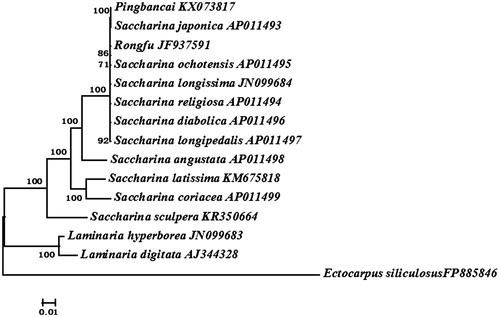Abstract
Saccharina is one of the most important economic seaweed. We presented the complete mitogenome of Saccharina variety ‘Pingbancai’ (Saccharina japonica × latissima) in this work. Circular-mapping mitogenome was 37,658 bp in length with overall A + T content of 64.70%, encoding 3 rRNAs (23S, 16S and 5S), 25 tRNAs, 38 genes (including 3 open reading frames, ORFs). Gene arrangement and component of ‘Pingbancai’ mitogenome were identical to those Saccharina species and cultivation varieties, which show highly conservative evolution in mitochondrial genomes within Saccharina. The phylogenetic analysis based on mitogenomes showed that ‘Pingbancai’ had a closer evolutionary relationship with Saccharina japonica than Saccharina latissima and the supported mitogenome was maternally inherited.
Saccharina (Laminariales, Phaeophyceae) have become an important raw material of the marine chemical industry (Jensen Citation1993). In China, more than 10 breeding varieties have been bred (Li et al. Citation2007; Zhang et al. Citation2011b), ‘Pingbancai’ is one of the most important economic Saccharina cultivation varieties. Here, we determine the complete mitogenome of ‘Pingbancai’ and construct phylogenetic tree of Laminariaceae, providing new molecular data for population diversity and phylogenetic study.
One specimen of ‘Pingbancai’ (accession number: 201004472) was collected from Li dao Bay, Shandong, China and stored at −80 °C in the Culture Collection of Seaweed at Ocean University of China. The experimental protocol and data analysis methods followed Zhang et al. (Citation2011a).
The complete mitogenome of ‘Pingbancai’ was characterized as a circular molecule of 37,658bp (GenBank accession number KX073817) with a nucleotide composition of 28.42% A (10,701), 14.72% C (5543), 20.58% G (7751) and 36.28% T (13,663). The mitogenome had an overall A + T content of 64.70%. Cumulative GC-skew (0.1660) and AT-skew (–0.1216) analysis of mitogenome reflected a slight bias towards G and T in nucleotide composition on H-strand. The mitogenome encoded 66 genes, including 3 rRNAs, 25 tRNAs, 35protein-coding genes and 3 ORFs. The gene arrangement and component were identical within Saccharina mitogenomes (Yotsukura et al. Citation2010; Zhang et al. Citation2011a, Citation2013), showing a highly conservative evolution. Excepting rpl2, rpl16, rps3, rps19, tatC and ORF130, 60 genes were encoded on H-strand. All protein-coding genes used standard codon ATG as their initial codon. All three typical stop codons are used with a preference of 68.42% for TAA, compared with 21.05% for TAG and 10.53% for TGA. This mitogenome carries 2445bp of intergenic regions accounting for 6.49% of the genome and 13 pairs of overlapping genes with the overlap size from 1 to 16bp were conserved in Saccharina mitogenomes. Moreover, all tRNA sequences were potential to form standard cloverleaf secondary structures.
All Laminariaceae species with complete mitogenomes available in the GenBank were selected to construct the phylogenetic tree by the Bayesian method. Phylogenetic analysis based on combined 35 protein-encoding genes exhibited the species were divided into two clades: Saccharina and Laminaria (), supporting current taxonomic systems (Yoon et al. Citation2001; Lane et al. Citation2006). It also showed that ‘Pingbancai’ firstly groups with S. japonica and then with S. latissima and validated that the mitogenome was maternally inherited.
Funding information
This work was supported by the National Natural Science Foundation of China (Grant No.31402300), the Fundamental Research Funds for the Central Universities (201562019) and TaiShan industrial Experts Programme.
Disclosure statement
The authors report no conflicts of interest. The authors alone are responsible for the content and writing of this article.
Reference
- Jensen A. 1993. Present and future needs for algae and algal products. Hydrobiologia. 269:13–23.
- Lane CE, Mayes C, Druehl LD, Saunders GW. 2006. A multi-gene molecular investigation of the kelp (Laminariales, Phaeophyceae) supports substantial reorganization. J Phycol. 42:493–512.
- Li XJ, Cong YZ, Yang GP, Qu SC, Li ZL, Wang GW, Zhang ZZ, Luo SJ, Dai HL, Xie JZ, et al. 2007. Trait evaluation and trial cultivation of Dongfang No.2, the hybrid of a male gametophyte clone of Laminaria longissima (Laminariales, Phaeophyta) and a female one of L. japonica. J Appl Phycol. 19:139–151.
- Yoon HS, Lee JL, Boo SM, Bhattacharya D. 2001. Phylogeny of Alariaceae, Laminariaceae, and Lessoniaceae (Phaeophyceae) based on plastid-encoded RuBisCo spacer and nuclear encoded ITS sequence comparisons. Mol Phylogenet Evol. 21:231–243.
- Yotsukura N, Shimizu T, Katayama T, Druehl LD. 2010. Mitochondrial DNA sequence variation of four Saccharina species (Laminariales, Phaeophyceae) growing in Japan. J Appl Phycol. 22:243–251.
- Zhang J, Li N, Zhang ZF, Liu T. 2011a. Structure analysis of the complete mitochondrial genome in cultivation variety ‘Rongfu’. J. Ocean Univ China. 10:351–356.
- Zhang J, Liu Y, Yu D, Song HZ, Cui JJ, Liu T. 2011b. Study on high-temperature-resistant and high-yield Laminaria variety “Rongfu”. J Appl Phycol. 23:165–171.
- Zhang J, Wang XM, Liu C, Jin YM, Liu T. 2013. The complete mitochondrial genomes of two brown algae (Laminariales, Phaeophyceae) and phylogenetic analysis within Laminaria. J Appl Phycol. 25:1247–1253.

